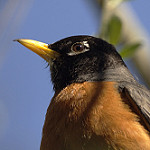Thousands of robins are visiting California’s central coast: lots more than usual, an ‘irruption.’ Unfortunately, I lack records of the timing of their arrival, but many people are talking about their astounding numbers, including: Feynner at Big Creek Reserv
e in Big Sur and Brock Dolman in Occidental, Sonoma County…and birders with the Monterey Bay Birds list serve. Feynner’s says maybe they came this way to avoid big burned areas inland and North. I counted 200 in about 10 minutes, flying in squeaky-talkative groups across a North Coast Santa Cruz field. This has been a daily occurrence for many weeks.
I have spent a little while standing among flocks of hundreds of robins in the fields and orchards at Molino Creek Farm, watching them. They scratch the mulch under the apple trees or poke at the ground in the fields, each bird holding their own few square feet. Some birds rest, alert high in nearby branches in two’s and three’s. I hear the crackle crackle crackle-squeak of a perturbed bird chasing away another, too close; they chatter their beaks by clicking them together rapidly when they seem especially territorial in a favorite food spot. These birds are apt to live up to the cliché, a worm hanging sideways out of their mouths.
Robins were Rachel Carson’s indicator species for the ‘Silent Spring.’ In 1950’s Michigan, researchers documented that elm leaves containing a pesticide applied to battle Dutch elm disease were digested by earthworms, and the earthworms by Robins. Pesticide poisoning made the Robins’ egg shells too thin, and they faced reproductive failure at a landscape level. Mornings got quieter and quieter in the Great Lakes states as the friendly dawn chorus of Robins quickly faded. Thanks to Rachel Carson and a host of others, America woke up and stopped large-scale broadcast spraying of pesticides.
Robins seem especially wise. Their gaze is intent. Someone once saw an American Robin sweep leaves aside using a twig- tool using intelligence. I imagine their vocal chatter is carrying lots of information. Their friendliness towards me suggests that they know I don’t eat them- people once hunted them for food. They are still food, but for other species: while hiking the other day, I walked towards a cacophony of Robin voices. As I do for all flocks, I spoke gently saying “don’t worry about me!” But, they wouldn’t stop and, after another dozen strides at my feet was a freshly dead Robin, neck broken, just killed…probably by a Cooper Hawk. Cooper Hawk and Sharp Shinned Hawks must be well fed this winter.
I’m pleased to have witnessed this Robin irruption, reminding me that terrestrial ecosystems of the Western United States can still produce bird abundance. This is the third irruption in recent years. 2014 was the Varied Thrush irruption. Winter of 2012/2013 was a Red Breasted Nuthatch irruption. What next? Don’t miss this one! Take time at dawn or dusk in the fields around the Central Coast to see the many Robins and hear their “chock chock” talk. (Check out their big beaks, too!).
